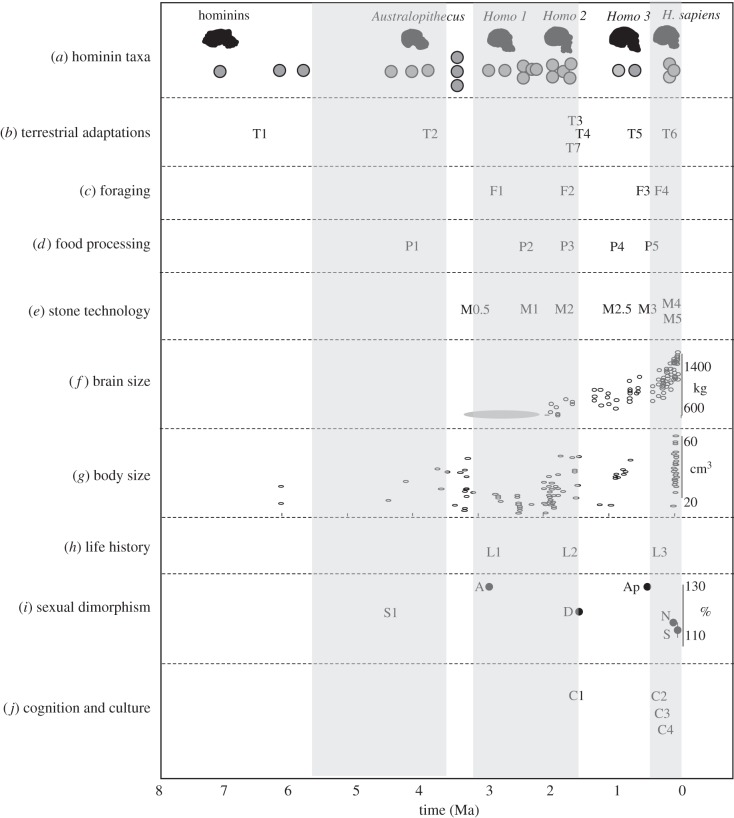Figure 5.
Chronological distribution of the first appearances of major derived traits in human evolution. Data points indicate earliest proposed evidence for the diverse traits, some of which are disputed or open to different interpretations. Sources of evidence are listed in references in the electronic supplementary material. The shaded areas indicate the three potential phases of transitions to novel adaptive zones. See text for discussion. (a) Hominin taxa: first appearance (FADs) for major groups (skull icons) and for species (grey circles). Same data as in figure 3. (b) Terrestrial adaptations: T1, suggestive evidence of some level of terrestrial adaptation through a greater level of bipedalism; T2, habitual bidpedalism as seen in A. anamensis and later australopithecines; T3, striding bipedalism as seen in H. ergaster/erectus, similar to modern human locomotion; T4, disputed evidence for a ground nest/shelter (DK1 at Olduvai Gorge); T5, some evidence for base camp usage; T6, full residential mobility patterns; T7, endurance running. (c) Foraging behaviour: F1, ephemeral evidence for processing of meat/animals; F2, substantial evidence for meat processing/butchery/scavenging/hunting, and possible use of some aquatic resources; F3, projectile hunting; F4, complex and specialized foraging such as specialist hunting, plant resource modification, systematic use of aquatic resources and foraging similar to living hunter–gatherers. (d) Food processing: P1, evidence for posterior dental enlargement in hominins; P2, posterior megadonty; P3, dental reduction in Homo; P4, fire and possible cooking. P5, substantial evidence for cooking and processing. (e) Stone technology: M0.5, earliest evidence for fracturing of stone (Lomekwian); M1, mode 1 technologies (Oldowan); M2, mode 2 technologies (large cutting tools, bifaces); M2.5, more regular and refined production of bifaces; M3, mode 3 technologies (prepared core); M4, mode 4 technologies (blades); M5, mode 5 technologies (microliths). (f) Brain size: data (in cubic centimetres) from figure 2, for Homo; range for earlier hominins indicated by grey ellipse. (g) Body size: data from figure 2 (in kilograms). (h) Life history: L1, early hominins show evidence of differences in life-history strategy from extant apes; L2, first evidence of a shift towards the life-history strategies of modern humans; L3, modern human life-history patterns shown in early modern humans, but distinctive patterns observed in Neanderthals. (i) Sexual dimorphism: S1, reduced canines observed in Ardipithecus ramidus; sexual dimporphism of hominin taxa shown in percentage of female body weight. Only those samples for which there are grounds for thinking they are a population are used. A, A. afarensis; D, Denisovans; Ap, Atapuerca; N, Neanderthal; S, H. sapiens. (j) Cognition and culture: C1, KNM-WT15000 does not show language-based adaptations in its thoracic vertebrae; C2, evidence for regional population behaviours in African Middle Stone Age, and for language related adaptations in both Neanderthals and modern humans; C3, diverse evidence for cumulative cultural processes and complex behaviours; C4, evidence for symbolic thought, communication and representations.

